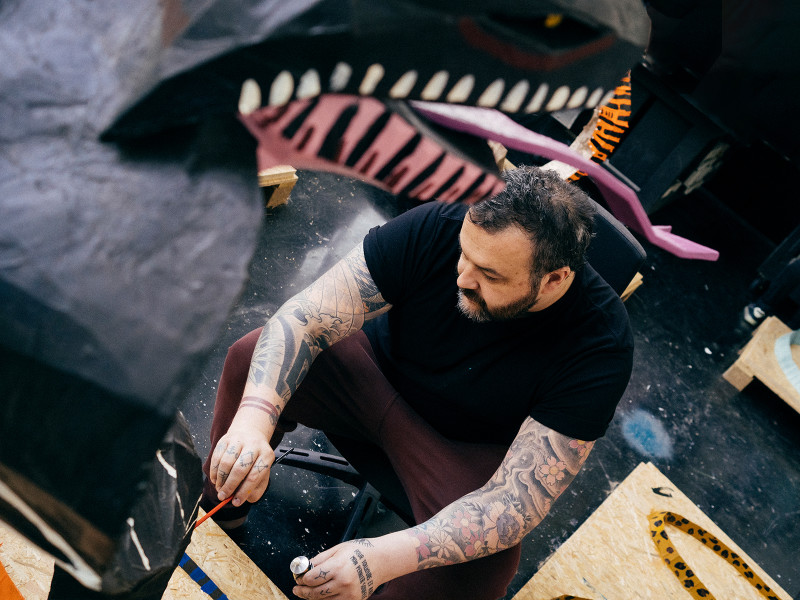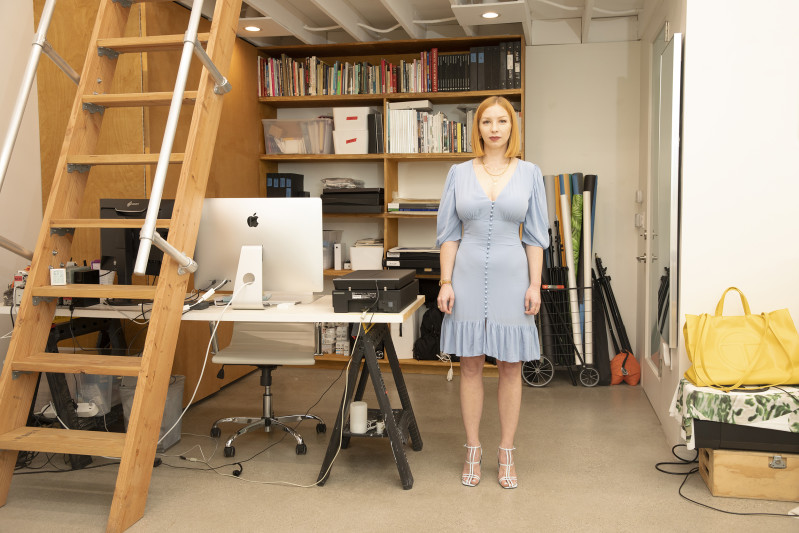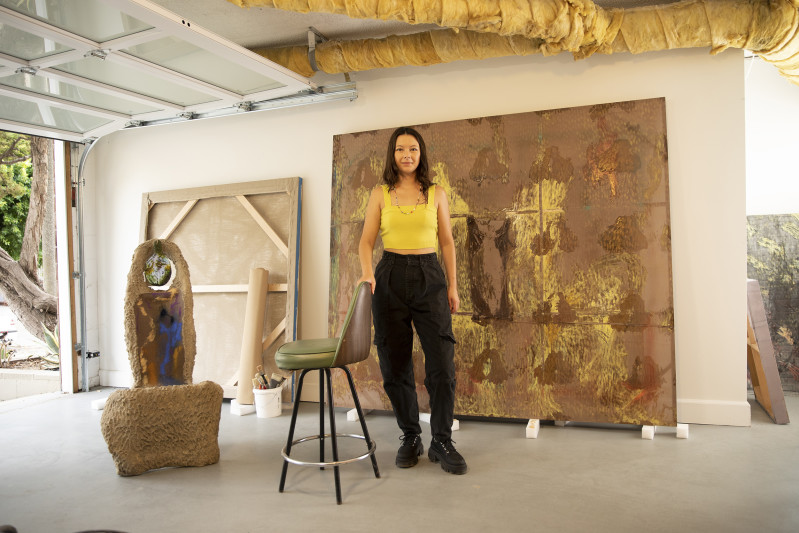Denise Rudolf Frank Jenise & Dordy
Interview
February 23, 2023
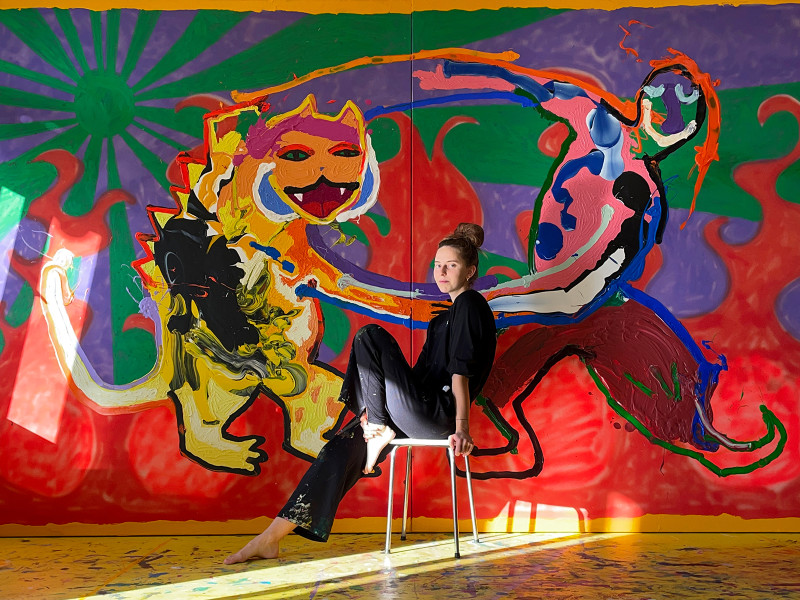
Who are you, Denise Rudolf Frank?
— I’m from Austria, born in Vienna. I came to art because I was brought to an art therapist when I was 3 years old. Because of a trauma, I stopped talking and shut down completely. Drawing or painting was the only way to express myself or get some information about me. I was in art therapy every week for 6 years, so drawing and painting meant to get over feelings and to express myself. It was like writing a diary. It became a habit, so when I don’t do it, I feel very overwhelmed by my surroundings and my dreams. For me, the only logical way to have a life that works was to become a painter. Since I need to do it every day, I can’t do another job.
Have you always lived in Vienna?
— I lived in a very small town in lower Austria, before moving back to Vienna when I was 14. It was a village where everyone knew everyone, I had to go to church, and religion was very important. For me, I didn’t feel threatened that no one understood me, I was like the weird person in the village. Later, I moved to London for half a year. In the last 15 years, I have moved 11 times in Vienna and around Austria. Now, I live in the woods of Vienna, which is more of the countryside surrounded by forest because I realised that cities are fun when you’re young but with the noise and everything, it gets too much for sensitive people. Vienna has always been a hub for exceptional art, from Gustav Klimt and Egon Schiele to Franz West. In the past few years, there has been a newfound interest in young artists, like Amoako Boafo and Alexandre Diop.
What is your experience as a young artist in Vienna?
— Actually, I studied with Amoako, he was next to my place. Because I started very early, it was clear that I only wanted to do this. I made my own exhibition when I was 12. Every year, I had two exhibitions, in the beginning it was in cafés and such places. I really had this group of people who had known my art. Vienna is not that big, people talk about it, so it was quite easy to sell my paintings. I feel like the galleries are more conservative here than in other cities but now it’s changing. Old galleries shift focus, small pop-up art spaces open... Maybe it’s because people my age are old enough to create something new.
You also studied at Central Saint Martins in London.
How do young artists in London differ from that in Vienna?
— I can’t talk about every university because The Slade is very different to Central Saint Martins. I wish I would have chosen the other ones because Central Saint Martins, for example, is very conceptual. When you are an expressive painter, for me it was very important to not have too many rules for myself when I begin a painting because then I destroy a lot of opportunities. For them, it was always so important that I “make” so much around a painting and decide everything beforehand. I didn’t understand this because creativity is limited. They always wanted to change someone. In Austria, I was guided by Daniel Richter and Kirsi Mikkola. Kirsi is very hard and frank, but she never wanted to change you. She realised your reason for being a painter. She helped us to grow ourselves. At Central Saint Martins, they have a thought about how an artist should be.
Has your arts education in London influenced your artistry?
— Yes. I was very aggressive at this time because I had this tutor who wanted to give me a bad grade. But I actually thought I was one of the most productive and best people in the class. She said I shouldn’t paint because my paintings are so aesthetically pleasing and beautiful, but it’s not interesting, so I should do performing arts because she thinks I’m good at that. I didn’t want to do that, so I was more like fuck you, and I’ll do what I want because I think it’s right. I think this was very important as well.

Denise Rudolf Frank PLEASANT NIGHTMARE, 2022, Acrylic and oil on canvas, 60x50 cm
You started art therapy as a young child. How has this impacted you as an artist?
— I learned a very important thing and I’m so happy that I came to art like this. For me, it’s not important what the painting is going to be, but it’s more the way of getting to the painting. It’s a very releasing process. I have very intense dreams every night, I can remember at least 5 or 6 dreams. They are mostly nightmares, but I’m so used to it, so the nightmares aren’t that bad anymore. For example, last night I dreamt that someone put knives in my stomach. It was a very beautiful shape, actually. I’m not awake, so it’s not as horrible, then it’s on to the next dream. In the morning, it’s very hard to think about something else because it’s so present. I mostly start painting in the morning, because I want to release everything and get rid of all my thoughts and doubts through the painting. My painting process starts with putting the empty canvas on the floor, and then I feel what I’m feeling, and I never know what it’s going to be. During the process, I sometimes see an animal, or a figure, or I’ll attract things, or a landscape, and I try to bring it out. The first part with acrylic paint alone takes 3-4 days to dry enough to hang the canvas on the wall, after that comes one of the most interesting parts. Then I can see what’s really happening myself. Art therapy tries to see something in your subconscious. Dreaming, like very quick painting, is the only way to get your subconscious consciousness. I had very traumatic experiences in my childhood, and I know the sadness and the anger are still in me. I am sensitive to all my surroundings, like climate change or critique. I hear it and it’s stuck in me. I think the trauma in my brain is scared to miss any danger, so I need the very intense dreaming and painting to release all these feelings.
This exhibition combines your paintings with the sculptures of Australian artist Jordy Kerwick. What is your relationship to sculpture?
— I used to do sculpture as well, with big tree roots. I love to make things in 3D. When you see my paintings in real life, you can see the paint is very thick. I only paint with my fingers, barely with brushes. I love it when something fills the room. I love the idea behind Jordy’s sculptures because they’re very rough, and almost naïve in a beautiful way. He’s just a funny guy, his first title was fuckface or something. I think it will work very well together because it’s approaching life from a funny side. The exhibition title ended up being Jenise & Dordy.
What are your thoughts about it?
— It was difficult for Jordy and me to find something since he wanted to have a funny joke as a title that doesn’t make it too serious. I absolutely appreciate that, I like when artists don’t take it too seriously. For me, I was thinking of titles like fear of happiness or titles of my paintings because I wanted to show the people very traumatic theories from the world in a very kind way. I don’t think mixing two different approaches in one title works, so it was easier to just mix our initials.
How would you describe this collaboration between you and Jordy Kerwick?
— I think we don’t take ourselves too seriously. This is a big part of it. We enjoy what we are doing. We have serious topics as well, but it’s not more important than enjoying the art. That is a big thing, I don’t need to read something to understand the painting or feel the painting.

How important are titles on artworks, in general and for you and your works?
— How I arrive at a title is that I’ll paint a painting, and I never know what it’s going to be. When it’s finished, I put it, for example in my dining room or kitchen and look at the painting for days. Then, I interpret my own painting, like maybe it’s this or that. For me, climate change is a big topic because the weather is very warm and we don’t really have winter anymore. They had to get rid of a lot of trees due to an insect eating the trees. It’s very present. For example, I have one painting that I’ve called Feets, the title isn’t finished yet but for me it’s about burning the Earth and the Earth getting warmer. At the same time, I have cold feet, so I find something related to that topic that came to me. I want to have a small sentence or small title to create the link, but I don’t want to say too much because I like that people have their own stories and see their own fears or things they’re going through in their own lives.
What is the inspiration behind the paintings in this exhibition?
— The inspiration, all the time, is my surroundings. My feelings, my dreams. As I said before, it’s more about climate change, and I try to get over all my fears with trauma therapy again. I think I know how the brain works and what the brain does when you have trauma, and how this changes you in a very big way. When you experience something bad, for example, now with the war, people need to leave their homes and they have seen a lot of blood and bad things. Then they come to Austria and they’re safe again, but the brain doesn’t want to let them feel safe because they’re scared that when they feel safe they’ll miss the next danger. They’re safer to stay in the stress mode, in fight or flight mode. This is a big topic where I try to understand how the brain is working about that. I read a lot about this topic, and I see it in many people that are now in wars. What is happening, hopefully when everything is over, is that they won’t feel unsafe anymore. It takes a lot of work to get healthy again.
The paintings in this exhibition vary in size. Is there a difference in how you approach large vs small works?
— Yes. The bigger works are more physical. I sometimes lie on the painting when it’s on the floor. It requires more strength. The smaller paintings are more meditative. The small paintings are often faces because there is more expression of a feeling. I did this before when I was in London, I had a very small studio and room. As I said before, I cannot not paint. I need to paint every day. I did one small painting every day, and it was more like a diary of feeling. I kept this because sometimes I would feel something, and I wanted to release this emotion.

The painting Dancing Fight is a very large-scale work, measuring at 400 cm in width. Can you elaborate on the creation process for this work?
— This work is actually not the biggest one that I did. I styled it in the woods. I started with spraying acrylic. I can’t do this inside because I live in the studio, and I need to be very careful with the chemicals. It was a very beautiful day, so I thought okay, let’s go to the woods with it. At first, it was very difficult because the trees where I laid the canvas weren’t straight, so it was hard to find an angle where it would work. It was nearly evening and there – with this red light from the sun, the ground in the woods looked like it was burning – I did this flame. I had this first layer only with flames, and I wasn’t able to do the next step because I didn’t know what to do next. I never did the first layer without doing the acrylic part as well. I wasn’t able to do it in the woods because then it wouldn’t work having it lying there for three days and maybe there would be an animal on the painting or something. I waited a long time until the next step. I think it was also a dream I had with the dancing animal. I was researching a lot of paintings by A. R. Penck. He is a painter from Germany, and he had very quick drawings and paintings where he painted the lion in a very dancey, aggressive way. For him, I think it was more of a fighting animal. For me, I thought it looked more like dancing. I wanted to show something fighting or dancing where you’re not really sure what it is. The title shows that you need to choose what they’re doing. Is it an aggressive way, or a beautiful, lovely way?
What motivates you to use such vibrant colours? Have you always used this palette?
— Actually, no. I started with only black and white. I think it’s getting brighter. I thought at some point it can’t get more colourful, but it is. It’s a challenge to make it brighter without it becoming too much. Some colours need to be mixed with others that are bright, but it’s not too much for the eye. The challenge is to make something very overwhelming but not too overwhelming. It’s still working only because it makes me happy. I think the world is sometimes so gray and dark, and now we have winter, and there’s less sun. My house is very colourful as well, and my clothes because I know it does something to your brain. There are a lot of studies that show that green, for example, will calm you, or that red is more aggressive or symbolic of intense love. I believe that colour does something to your thoughts, so I play with them.
Gallery



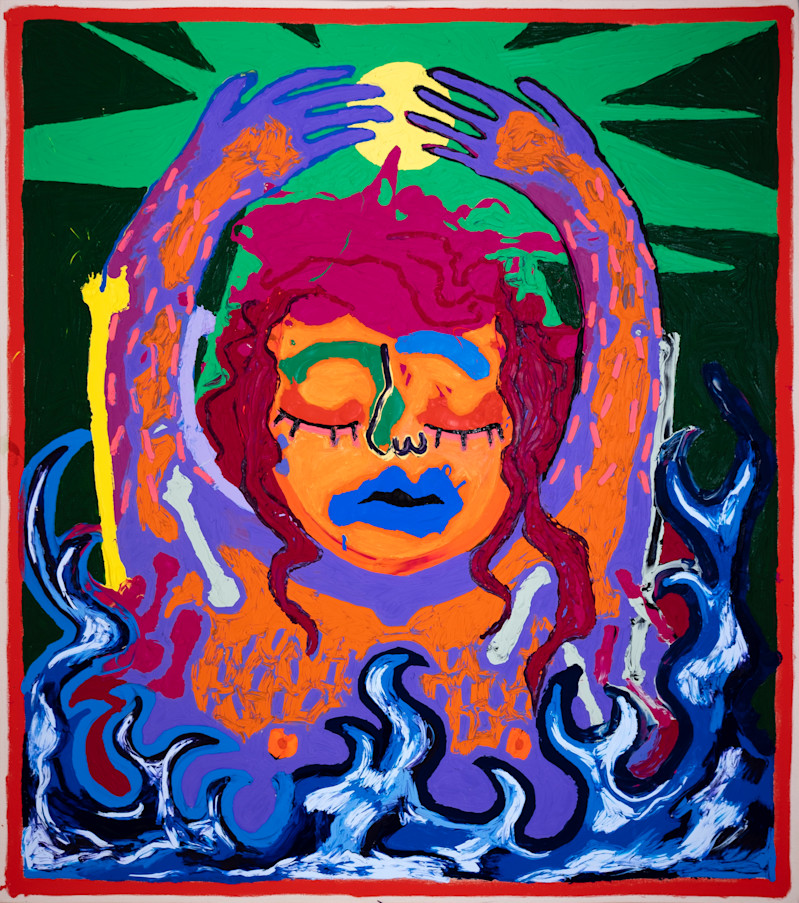



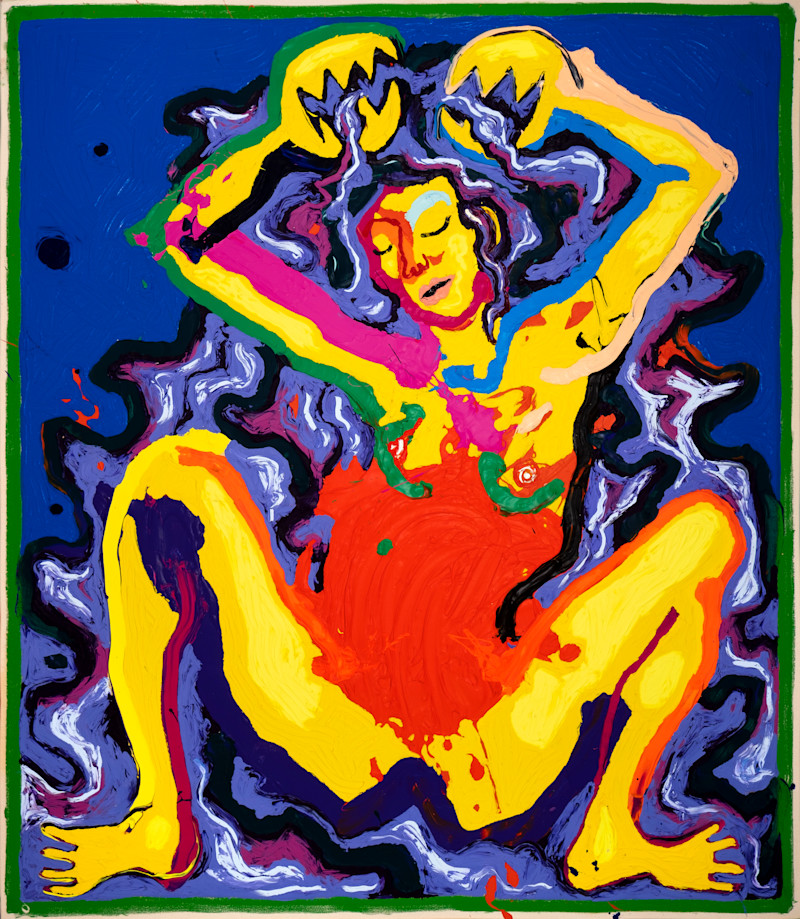




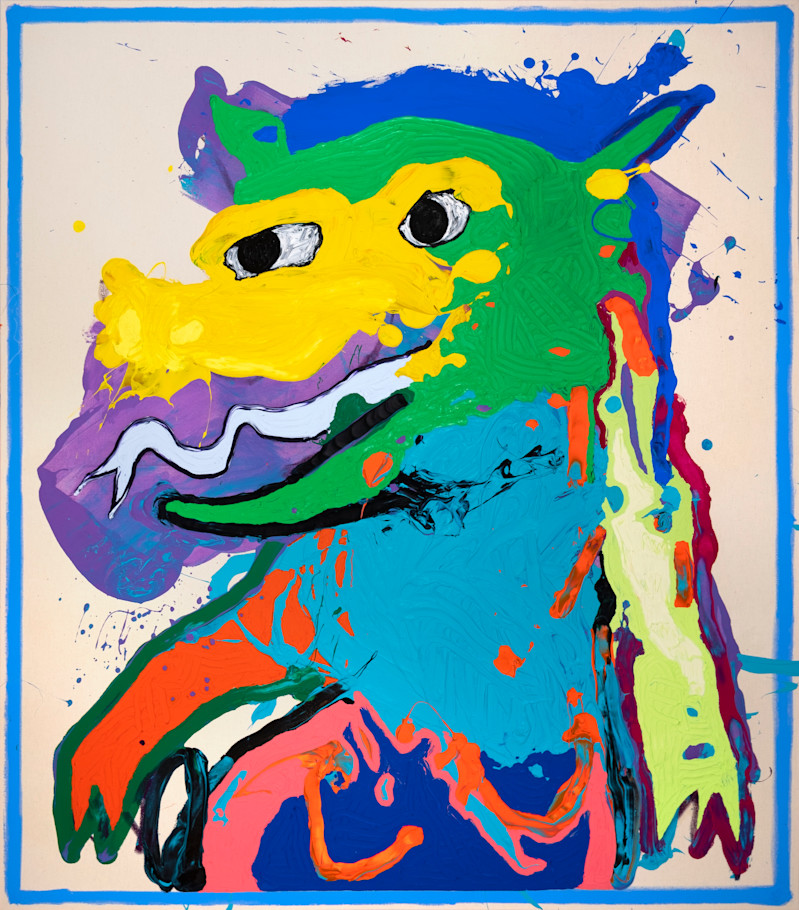

Denise Rudolf Frank Jenise & Dordy














Denise Rudolf Frank WET DREAM, 2022, Acrylic and oil on canvas, 160x140 cm
Denise Rudolf Frank PLEASANT NIGHTMARE, 2022, Acrylic and oil on canvas, 60x50 cm
Denise Rudolf Frank SELFMADE APOCALYPSE, 2022, Acrylic and oil on canvas, 210x190 cm
Denise Rudolf Frank MAD HAT, 2022, Acrylic and oil on canvas, 60x50 cm
Denise Rudolf Frank SUN BURN 2022, 2022, Acrylic and oil on canvas, 60x50 cm
Denise Rudolf Frank THE FASTEST AND MOST PLEASANT WAY TO DIE, 2022, Acrylic and oil on canvas, 160x140 cm
Denise Rudolf Frank DANCING FIGHT, 2022, Acrylic and oil on canvas, 250x400 cm
Denise Rudolf Frank DEFEAT THE INNER PIG, 2022, Acrylic and oil on canvas, 160x140 cm
Denise Rudolf Frank BLOW UP, 2022, Acrylic and oil on canvas, 180x200 cm
Denise Rudolf Frank DAYDREAMERS AT NIGHT, 2022, Acrylic and oil on canvas, 60x50 cm
Denise Rudolf Frank ACROSS BORDERS, 2022, Acrylic and oil on canvas, 180x195 cm
Denise Rudolf Frank THE FEAR OF HAPPINESS, 2022, Acrylic and oil on canvas, 200x250 cm
Denise Rudolf Frank MOTHER EARTH, 2022, Acrylic and oil on canvas, 160x140 cm
Denise Rudolf Frank A WOMANS BURDEN, 2022, Acrylic and oil on canvas, 160x140 cm
